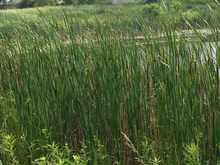Quick facts
Narrow-leaf cattail is an unlisted non-native species. These species have no restrictions on sale, purchase, or possession, but they may not be introduced into a free-living state without MN DNR approval and thorough evaluation.
-
Narrow-leaf cattails are found in disturbed native wetland communities.
-
They can develop large monocultures, outcompete native vegetation and will crossbreed with native, broad-leaf cattail.
- Narrow-leaf cattails should be reported.
See the Minnesota Department of Natural Resources recommendations for reporting invasive species.
How to identify narrow-leaf cattails
- Narrow-leaf cattails (Typha angustifolia) is a perennial.
- Can reach heights of four to twelve feet.
- Brown cylindrical flowering heads on slender green stocks.
-
Easily confused with native broad-leaf cattails (Typha latifolia).
Leaves
-
Dark green, sword-like leaves.
-
Typically between one fourth to one half inches wide.
-
Originate from the base of horizontal stems.
Flowers
-
Velvety brown, cigar-shaped spikes.
-
two to six inches long.
-
Gap between the lower (female) and upper (male) flower of one inch or more.
-
Sheds pollen in single grains.
Seeds
-
Stored within the spike, each plant can produce and disperse up to 250,000 seeds.
-
Seeds are wind-dispersed and can remain viable for 50–100 years.
Roots
-
Can reproduce vegetatively through rhizomes.
-
Rhizomes in cattail colonies can become intertwined and form thick mats.
Reviewed in 2019



